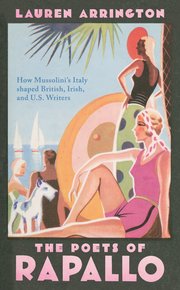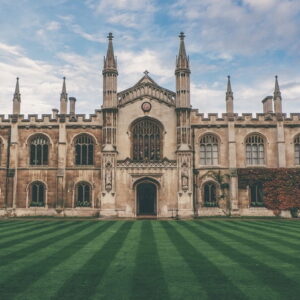
Ezra Pound’s Unrepentant Ties With Fascist Italy
Lauren Arrington on the Poets of Rapallo and Women’s Forgotten Involvement
When Elizabeth Bowen visited Rome in 1934, she had an audience with the Pope. “And,” as she wrote to Virginia Woolf, “I was given a seat in the Facist [sic] stadium to watch, a few feet away, Mussolini on a white horse reviewing police-dogs, bands, tanks—that was awful.” But every aspect of the regime was not so repulsive. Bowen was fascinated by the architectural recovery projects that Mussolini imagined would create a link between a contemporary civic identity and an historical past. In her letter to Woolf, Bowen described what she saw happening around her: “They have opened and flattened-out and dug up a great deal of Rome since I was last there, ten years ago.” The results impressed her:
I like ruins to look as large as possible and the Colosseum looks more volcanic without grass [….] I wish the Renaissance had not been such robbers, chipping and stripping [marble] off everywhere for somewhere else. It seems hard on Roman Rome to have to look picturesque.
Mussolini’s projects were having their desired effect, making ancient Rome feel more immediate, relevant, and appealing:
Before when I was in Rome I was so ignorant that I took a distaste for the Romans as rather bleak people who preferred to live in big nubbly buildings of brown brick. It has certainly taken me a long time to learn anything at all.
Unsurprisingly, Bowen didn’t write about any of this in her travelogue A Time in Rome (1960). Like so many other Irish, British, and U.S. writers who were in Italy in the early years of the regime, she was retrospectively covert, eager to disguise her proximity to the toxic politics of the 1930s. Famously unrepentant, of course, was Ezra Pound, who gathered a surprising array of writers around him in the small town of Rapallo, near Genoa on the Ligurian Sea. W. B. Yeats, Richard Aldington, Thomas MacGreevy, Basil Bunting, and Louis Zukofsky were all in Rapallo, some for short visits and others staying for months on end. They engaged to varying degrees with the cultural politics of the regime and with one another, all orbiting around Ezra Pound who manufactured disagreements as often as he forged friendships.
The legacy of Rapallo in the work and lives of these men is discreet but discernible. It’s far more difficult to trace the importance of Rapallo for the women who were there—George Yeats with W. B., Brigit Patmore with Richard Aldington, Marion Bunting with Basil, Dorothy Pound (sometimes) with Ezra.
The legacy of Rapallo in the work and lives of these men is discreet but discernible. It’s far more difficult to trace the importance of Rapallo for the women who were there.
Woolf’s 1938 treatise Three Guineas proposes that the Totalitarian Man, “called in German and Italian Führer or Duce; in our own language, Tyrant or Dictator” is the product of the inequality of the sexes and the dissociation of the ethics of literature from the ethics of other spheres of life. Woolf argues to the contrary, “the public and private worlds are inseparably connected”; if men “forget the private figure, or if we [women] in the intensity of our private emotions forget the public world,” then “such will be our ruin.”
But if the public and private are regarded as “one world, one life,” and men and women work in partnership, the “evil” can be defeated. She reasons that this can only be achieved with a respect for women’s difference: “we can best help you to prevent war not by repeating your words and following your methods but by finding new words and creating new methods.”
The different ways that Brigit Patmore, Dorothy Pound, Marion Bunting, and George Yeats spent and accounted for their time in Rapallo demonstrates Woolf’s argument about the inseparability of private and public spheres. Dorothy Pound’s sympathies for the fascist regime were not explicitly addressed in her art but are encoded in the aesthetics of her architectural drawings and watercolors. Long before the publication of her only book Etruscan Gate (1971), which is a tribute to Ezra, she actively established her reputation as subservient wife rather than take credit for her work as an independent artist or even as Ezra’s collaborator.
In 1955, when the Pound scholar Douglas Hammond asked Dorothy if she would meet him, she replied that “Americans” were ‘‘rather stupid” when it came to understanding Italy, the war, and Mr Pound’s activities. She said that her one purpose right now is to keep “Ezra happy and reasonably well” so that he may complete the cantos on which he is presently working.
Brigit Patmore’s disapproval of Dorothy’s wifely devotion slips through in her memory of dancing with Ezra, whom Patmore describes as moving “with extremely odd steps [….] [It was] easier to waltz with a robot.” But Dorothy, “sweet, faithful Dorothy said innocently: ‘Ezra has a wonderful sense of rhythm.’ Yes indeed.” Even in Patmore’s private, unpublished journals, she seems reluctant to give her outright opinion of Ezra and Rapallo. In an undated notebook, she reflects on how her gender affected her capacity to write:
I resist my own desire to expression in every way; I do useless things—clean a couch, tidy a drawer, think out letters and messages even darn stockings, a loathsome depressing job rather than bring out my thoughts imaginations & life-reactions. Is it a childish distrust & suspicion, & dislike, fear of ridicule or is it female secretiveness—the life inside sufficient—also because I have always been reduced to silence through living with people who were not interested in my interests?
Pamore’s relationship with Aldington was symptomatic of what she perceived as a lack of respect and support. His constant need for her approval of his work meant that she was always reading his writing, leaving no time to focus on her own. When their liaison ended, Patmore re-entered life as a writer and began to process, in a very public forum, what she had experienced in Italy.
Dorothy Pound’s sympathies for the fascist regime were not explicitly addressed in her art but are encoded in the aesthetics of her architectural drawings and watercolors.
In 1930, Patmore wrote an essay for the British women’s weekly, The Sphere, which offered political commentary that was often thinly veiled by “feminine” concerns. Patmore’s article takes the guise of a piece on European travel, but it also speaks to her complicated private life with Aldington, her impressions of the poets of Rapallo, and her ideas about the fascist regime, a subtext indicated by her provocative title “A traveller’s lament on things one is never told.” She describes Italy as:
one of these plaguey spots on the map for me; first, because to be British and not know Italy is not to know your own father, and yet never to hear the end of that paragon of parents; and secondly, because everybody’s been there. This last reason is a nasty, envious one, but it’s difficult to be a prisoner against your will and noble all the time.
Privately, Patmore confessed that only two people “could influence [Ezra] intellectually, & they, Ford Hueffer & Wyndham Lewis, were not in Italy.” While “Yeats was someone he honoured & I think, loved,” Pound “looked for no guidance from him: indeed I doubt if he would accept direction from anyone, his confidence & courage & self-will were enough.”
In Patmore’s account in The Sphere, she makes it clear that she is not sympathetic with the Italian fascist regime or its aesthetics:
I was confused by the innumerable Roman remains. Remains is a dreary word—suggests crumbs from a feast, left-overs—it rhymes with drains. Unattractive. And broken columns, forums, Roman roads (always going straight where they wanted, drat them!), Julius Caesar (a feeling that there’s some uncollected tax owing to him still!), busts of men awfully like the nicest elderly men I knew, but without their stiff collars.
For Patmore, Roman ruins did not signify a latent, spiritual state awaiting resurrection; her Italy is haunted by the specter of an unsatisfied dictator, waiting for the settlement of old debts. There was nothing pleasing to Patmore in the straight lines and hard edges that Dorothy Pound found so compelling.
*
George Yeats was an extensive collaborator in her husband’s work, and after W. B.’s death she was an attentive editor and a vigilant administrator of his literary estate. In her biography Becoming George, Anne Saddlemyer draws a parallel between Dorothy’s life in the 1950s and George’s in the 1930s, “when she too was trying to keep her husband’s poetry alive.” Saddlemyer asserts that it was not until W. B.’s brother Jack Yeats’s death in 1957 that “ ‘our rock George’ was freed at last from attendance on Willy’s generation.”
Saddlemyer goes to great lengths to show how George Yeats was instrumental in W. B.’s creativity, but to imply that George was never fully herself during the marriage is to neglect the ways that the couple’s collaborations spoke to their shared political and philosophical views and the ways that these ideas relate to aesthetic concerns. Margaret Mills Harper’s book Wisdom of Two, about the making of the esoteric book A Vision, illustrates the multiple and important ways that George was a progenitor of the books’ aesthetics.
Although the 1937 iteration of A Vision shows Yeats’s disillusionment with the idea of the Italian fascist state (‘only dry or drying stick scan be tied into a bundle’), as Paul Corner demonstrates in his work on “Collaboration, Complicity, and Evasion,” this kind of disillusionment was common in the late 1930s, when “even confirmed fascists were reduced to complaining about the ‘little Mussolinis’ who, strutting in their ‘Napoleonic uniforms,’ dominated many Italian provinces.” While W. B. Yeats’s writing from the mid-1930s illustrates his disagreement with the Italian incarnation of fascism, this does not indicate a rejection of the fascist ideal or aesthetic fascism as artistic practice.
Most of the other poets of Rapallo regarded W. B. and George Yeats’s mysticism as absurd. Aldington wrote to MacGreevy in 1958,
I kept up correspondence with Ezra in that dreadful captivity (the C. of E. instructs us to succour captives) and he offended me by writing that ‘of course Yeats was a gargoyle’. I re-read him [wby] down here in this damp little hamlet smelling of cows and cabbages, and he seems more than ever a great and noble spirit. I can’t follow him into that Vision book—remember? How right you were at Rapallo when you made me see that he and George looked like witches. They did. But that makes no difference to the great and soaring spirit he was. ‘It was the bananas that levitated, and not the lady.’
But Basil Bunting identified a sinister aspect to the Yeatses’ spiritualism: he detected in their use of magic a mechanism for exerting “power”: Yeats “thought of himself as one of a governing class, with obligations, but with privileges too [….] Yeats felt he had a right to power that he did not share with the greater part of mankind. If you have none of the real power of armies and police and huge fortunes, magic is an unsatisfactory, but often irresistible way of pretending to yourself that you have an equivalent.”
Bunting only considers W. B. in his letter—presumably relegating George to domestic irrelevance—but she was the medium for (and, most critics agree, the inventor of) the spirits who communicated the philosophy. Scholars have acknowledged the timely revelation of George’s mediumship, coming into fruition just as W. B. was struck by post-wedding cold feet. If George’s spiritualism was a means of obtaining or retaining power in her domestic life, then it is equally true that her ideas enforce the assertion of power in the public sphere.
In his remembrance of George Yeats, “Hours with the Domestic Sybil,” Donald Pearce writes, “As I think back about George, it is surprisingly Ezra Pound, of all the people making up her husband’s literary circle, whom she most resembled. They had the same down-to-earth, no-nonsense directness […] each, moreover, preserved a kind of private inner mysticism.” Pearce relates George’s admiration for Pound’s “gifts,” “his art,” and “his endless sense of fun and wonderful irrepressibility,” and her somewhat odd comparison of Pound and D’Annunzio; she told Pearce, “If you put your hand on Gabriel D’Annunzio’s hair—he had a great shock of silver hair—and pressed down, it would stay flat.
But if you pressed down on Ezra’s hair—poof!—it would spring right up again!” This observation was followed by a “hearty, slightly wheezy laugh, head tipped back, eyes twinkling, but engaging me fixedly, as if an important confidence had just been imparted. As, of course, it had.” Pearce presumes George wanted him “to realize and enjoy that side of Ezra,” not pursuing—or at least not disclosing—the occasion of George’s proximity to D’Annunzio, who was known as “the first Duce,” or its implications.
During the Second World War, George Yeats “listened secretly to Pound’s broadcasts from Italy to America that began in January 1941”; Saddlemyer concludes, “no matter what he said, the sound of Ezra’s voice brought a lost world somewhat closer.” Daphne Bush’s recollection of George’s listening to the broadcasts makes it clear that George understood fully the illicit nature of Pound’s ideas and her own act of listening in: Bush was “shocked” when after dinner one evening, George suggested “in a humorous, half-conspiratorial sort of way ‘Let’s listen to Ezra.’” After the Second World War, George was concerned about what had happened to Ezra, as were so many of his friends who agreed or disagreed with his opinions.
She enlisted the young scholar Richard Ellmann to investigate and was relieved to hear that Pound was in the United States, having escaped “the custody of un-intelligent military officials who think poets are punk.” But when George heard about his confinement in St Elizabeth’s, she “raged” to David Clark, “It’s like caging a tiger” to lock up someone “so completely alive, so bursting with splendid energy.” Ten years on, George asked Paul de Man (who would be posthumously outed, in 1988, as a Nazi collaborator) to visit Pound in hospital and to send her news of his condition. Pound wrote to George in 1947 asking for news of other people that could distract him from his surroundings, and after his release from St Elizabeth’s, he corresponded with her from Italy. In 1965, after Pound attended T. S. Eliot’s memorial service in London, he went to see George in Dublin. The record of their meeting is as sparse as the silence that surrounds George’s politics; Ellman describes them as two friends, sitting beside one another, unspeaking.
The silences and obfuscations—deliberate and unintentional—about Rapallo that were propagated by the poets themselves and by the generations of scholarship that followed have only recently begun to be broken: in detailed biographies including Foster’s W. B. Yeats, Moody’s Ezra Pound, and Burton’s Basil Bunting, alongside Paul and Harper’s extensive studies of W. B. and George Yeats’s A Vision that situate those books in their historical and philosophical contexts.
The Poets of Rapallo shows the extent of the network that reached out from the small, unassuming town on the Ligurian coast. The creative work that occurred in Rapallo and that was undertaken afterward in response to private conversations and public events there demonstrates late modernism’s outward turn; their experiments with everyday speech and demotic forms were sometimes—but not always—democratic. The poets of Rapallo have in common a change in literary style that was an attempt to create publicly engaged works of art that would not stand apart from the world, as high modernism had done, but would actively shape it.
Thanks to Julia Parry for bringing the letter from Bowen to Woolf to the author’s attention.
__________________________________

Excerpted from The Poets of Rapallo by Lauren Arrington. Reprinted with permission of the publisher, Oxford University Press. Copyright © 2021 by Lauren Arrington.
Lauren Arrington
Lauren Arrington is Professor of English at Maynooth University, where she also serves as Head of Department. She has held distinguished visiting fellowships at Boston College, Trinity College Dublin's Long Room Hub Arts and Humanities Research Institute, the Harry Ransom Center at the University of Texas at Austin, and Cambridge University's Centre for Research in the Arts, Social Sciences, and Humanities. From 2009 to 2019, she worked at the University of Liverpool, where she reached the rank of Professor of Modern Literature. She was Adrian Research Fellow in English at Darwin College Cambridge from 2008 to 2009. Her doctorate is from Oxford University. In addition to her scholarly books with Oxford University Press, Clemson University Press, and Princeton University Press, her writing has appeared in TLS and the Irish Times.












